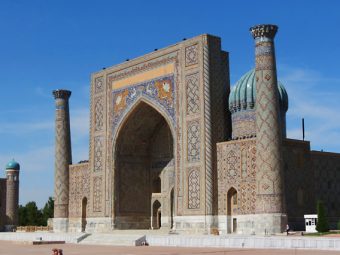As you retrace the trails of ancient treasure-laden caravans in the shadows of majestic architectural masterpieces along the Central Asian section of the Silk Road, you might be tempted to pause for a minute to envision everyday life as it would have unfolded amongst these monuments: the sounds and sights of streets that spun the ever-intermingling strands of danger and levity, of the mundane and the ephemeral, of life and art in all their cacophonous glory. Luckily, there is a way of gaining a chink of insight into this world, and it is through…
Photo by am98563
A vibrant strand of living history
The ancient art of silk printing. According to a leading Tashkent art critic, hand-made printed cloth was a widespread and well-developed craft in the 11th century AD in Uzbekistan. One of the main centres was at the weaving town of Chitgaron, near Bukhara, whose entire population was engaged in producing printed fabrics. As you would imagine, communities organized themselves around aspects of the production process: in one neighbourhood were the weavers, another group made mineral and vegetable dyes, wood carvers made intricate kalyb (blocks) to apply pattern on a cloth, like this Indian master does in this video:
A temporary decline
Sadly – and inevitably – as materials and techniques used in printing technology developed, more and more artisans found themselves being put out of business, and over the next few centuries the tradition was almost completely abandoned. The main dye (black), made from metallic rust, pomegranate peel and Iranian bean seeds, to which is added apricot resin as a thickening agent, was first to be replaced by synthetic ink. The red dye, derived from a plant ruyan, soon followed suit too.
…And recent revival
It was only in the 1970s, with the opening of an Indian shop in Tashkent, that Uzbeks saw that those Indian fabrics were printed using the same techniques as their forefathers. This spurred them on to seek out artisans who still practised the ancient art so that they could revive the lost and forgotten secrets of block painting, known in Uzbekistan as chitgarlik. Craftsmen collected ancient looms and kalyb, studied museum exhibits (Tashkent’s Museum of Fine Arts and the Applied Arts Museum have splendid exhibits) and began resurrecting the art. Their still-ongoing efforts have paid off: there is now a a chitgarlik reference book in the pipeline too, which will include information about kalybs, natural dyes, dyeing methodology and proper printing techniques. It will published in English, Russian and Uzbek.
A heartwarming victory: a small business with a great reputation
One contemporary artisan, Yuriy Pak, working with just two assistants in Tashkent, produces about 1,000 scarves a year, which retail in Uzbekistan for around $25 apiece in boutiques and gift shops. They source their silk from the celebrated Yodgorlik factory in Margilan and dye it in their workshop using the natural ingredients we spoke of above – plus anything from walnuts and pistachios to berries and onion skins.
Their efforts to make each and every scarf as unique as the buyer it finds have since paid off in ways even they couldn’t have anticipated: prominent figures of the fashion world have already begun to pay them regular visits. As can you, when you visit Tashkent as part of the lifetime adventure that is your Central Asia Rally.






Leave a Reply